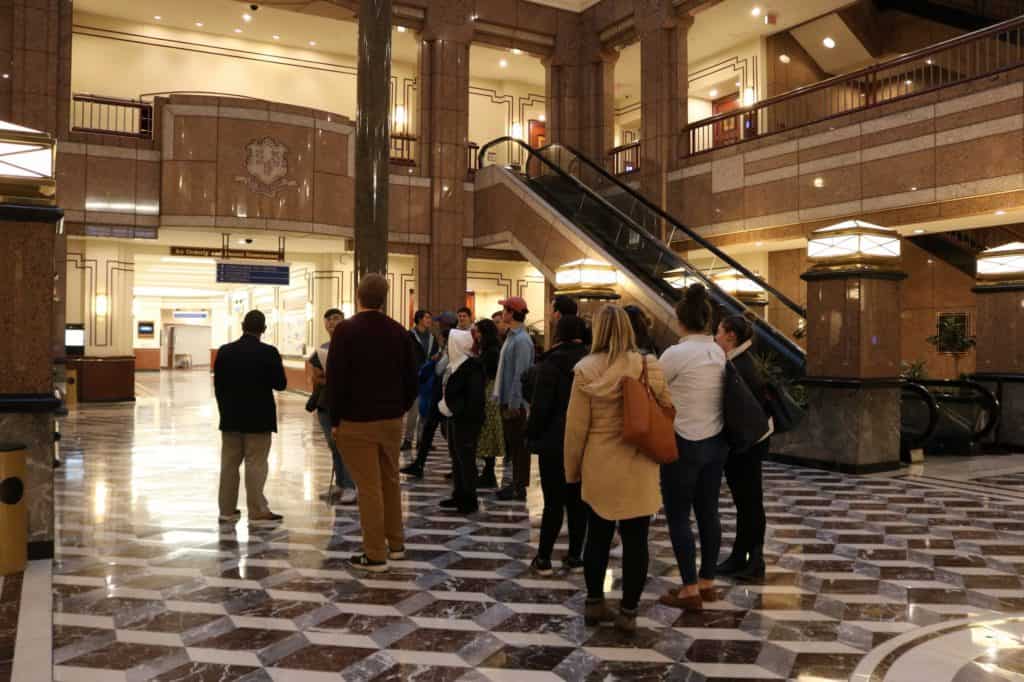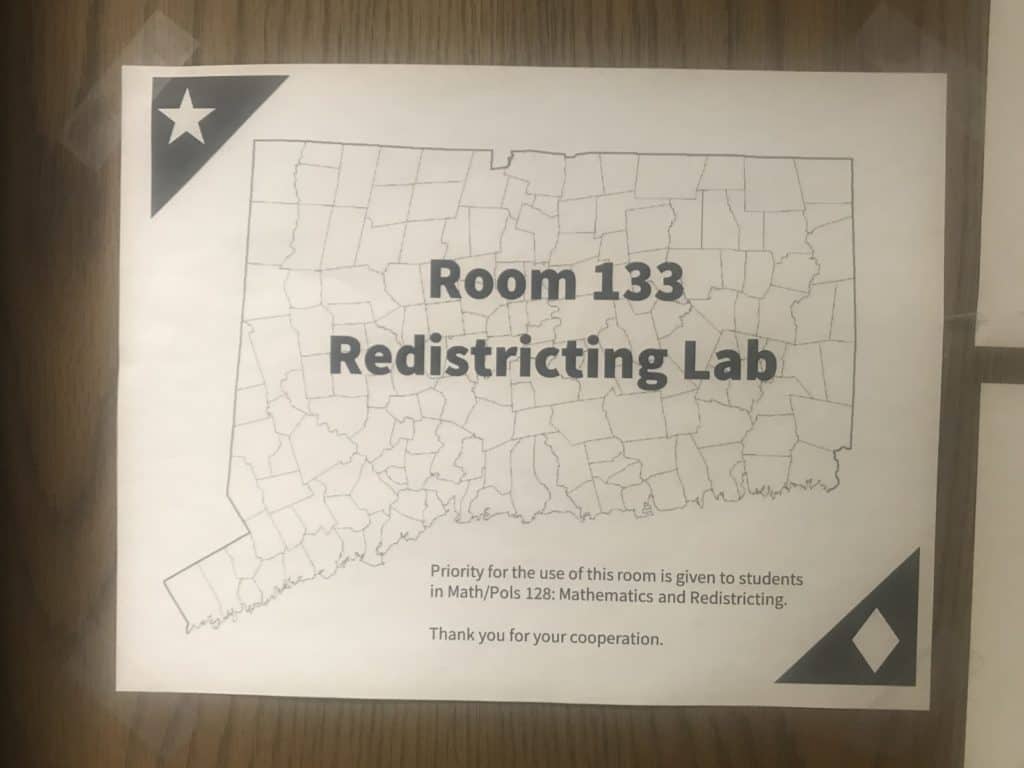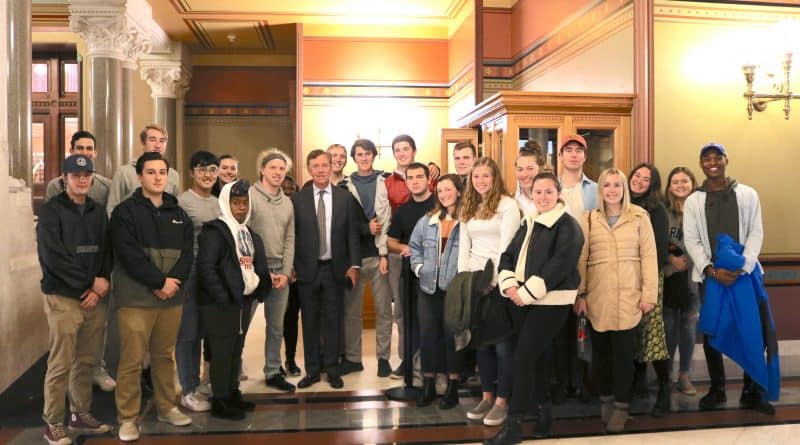Trinity Course Studying Gerrymandering Visits State Capitol, Drafts Redistricting Maps
Why are our legislative district maps shaped the way they are? Trinity College students in Visiting Assistant Professor of Mathematics Kyle Evans’s “Mathematics and Redistricting” course are learning about the mathematics and laws surrounding gerrymandering (manipulating elections by redrawing district boundaries to favor one party) and their impact on the shapes of maps and on elected candidates in national and state elections. “Mathematics and Redistricting” has been a hugely popular first-time Community Learning course at Trinity and is in especially high demand for Public Policy & Law students, as well as students across departments.
The relationship between math, politics, and social justice is a critical component of “Mathematics and Redistricting.” Throughout the semester, students examine course notes, videos, and readings on key concepts such as redistricting policies, the rise of independent commissions, the Efficiency Gap, compactness tests, racial gerrymandering, prison gerrymandering, residential segregation, major court cases involving redistricting and the role of mathematics in law, and more—and their learning is timely. The district shapes will be back in the spotlight next year following the 2020 Census and the decennial cycle of redistricting to follow. Additionally, students are following a timely ruling by the U.S. Second Circuit Court of Appeals to allow a Connecticut federal court to hear a constitutional challenge to the way Connecticut assigns prison inmates to legislative districts. This the first “prison gerrymandering” case in the U.S. that will be heard by a federal court.

In this course, students are gaining a first-hand understanding of how redistricting works in Connecticut. Evans organized small group interviews with key legislators and aides who have worked on redistricting as well as a tour of the Legislative Office Building and the State Capitol with state Rep. Jason Rojas (D-East Hartford), who also works at Trinity as chief of staff to the president and associate vice president for external affairs. Although the class is delving deep into redistricting law, their tour with Rojas helped them to contextualize redistricting amongst other high-profile political issues currently facing the legislature like transportation plans and gun laws.
Harrison Silver ’22 said, “Kyle is definitely one of my favorite professors and was honestly the first person to make math interesting for me. With the ability to combine math with tackling real-world problems, such as gerrymandering, we have been able to gain a deeper understanding of political issues in our society. We’ve had lectures from people who work on redistricting and an exciting field trip to the Legislative Office Building (LOB) and State Capitol. These are opportunities that other courses don’t offer. This course has also given us the ability to use unique software to examine redistricting from a more in-depth perspective.”
 In the classroom, students have worked with their professor and fellow classmates to learn how to analyze U.S. Census and election data and different mathematical approaches used to analyze maps, and thanks to Evans, Trinity’s Raether Library and Information Technology Center is now home to what’s called the “Redistricting Lab,” where students in the course have been granted access to Maptitude for Redistricting—software used by many state governments—for one semester’s academic use. In the Redistricting Lab, the students will work together and act as a “Redistricting Commission” to create and propose a new Congressional, state Senate, or state House district map for Connecticut.
In the classroom, students have worked with their professor and fellow classmates to learn how to analyze U.S. Census and election data and different mathematical approaches used to analyze maps, and thanks to Evans, Trinity’s Raether Library and Information Technology Center is now home to what’s called the “Redistricting Lab,” where students in the course have been granted access to Maptitude for Redistricting—software used by many state governments—for one semester’s academic use. In the Redistricting Lab, the students will work together and act as a “Redistricting Commission” to create and propose a new Congressional, state Senate, or state House district map for Connecticut.
During the recent tour of the LOB and State Capitol, Kent Shi ’20 explained that he had never liked math before taking this course. Shi said, “I’m a public policy & law and Hispanic studies double major and so I had experience interning here for a lobbying firm and for Hartford City Councilwoman Wildaliz Bermudez [’04]. I knew I also wanted to have some more quantitative experience, so I decided to join Kyle’s class. This class has shown me that I actually love math and how it’s useful in these big political issues.”

Reagan Flynn ’23 added, “[This tour] really contextualized a lot of the legislative action we had been learning about in class. This was a great way to utilize the specific resources we have here at Trinity, being located right here in Hartford. Our Capitol tour with Jason Rojas was, in my opinion, one of the coolest things we have done so far in this course. Also, meeting the governor was really awesome!”
Evans developed this course with the support of a Community Learning Faculty Fellowship in 2018-19. To view slides, assignments, and more information about “Mathematics and Redistricting,” visit his web page.
To learn more about Trinity’s Community Learning courses—which include experiential learning, collaborative partnerships, and perspective-building relationships—click here.
This story originally appeared on the blog of Trinity’s Center for Hartford Engagement and Research (CHER).
